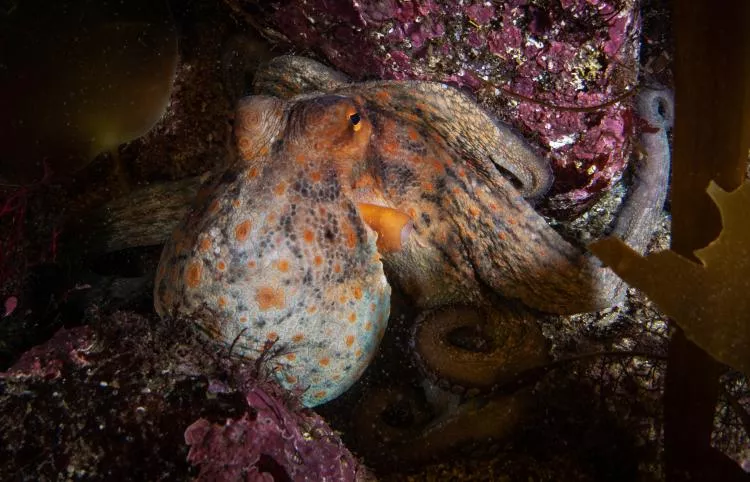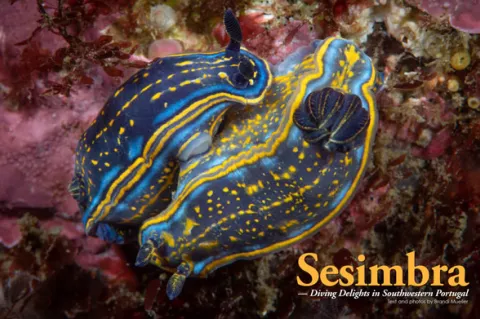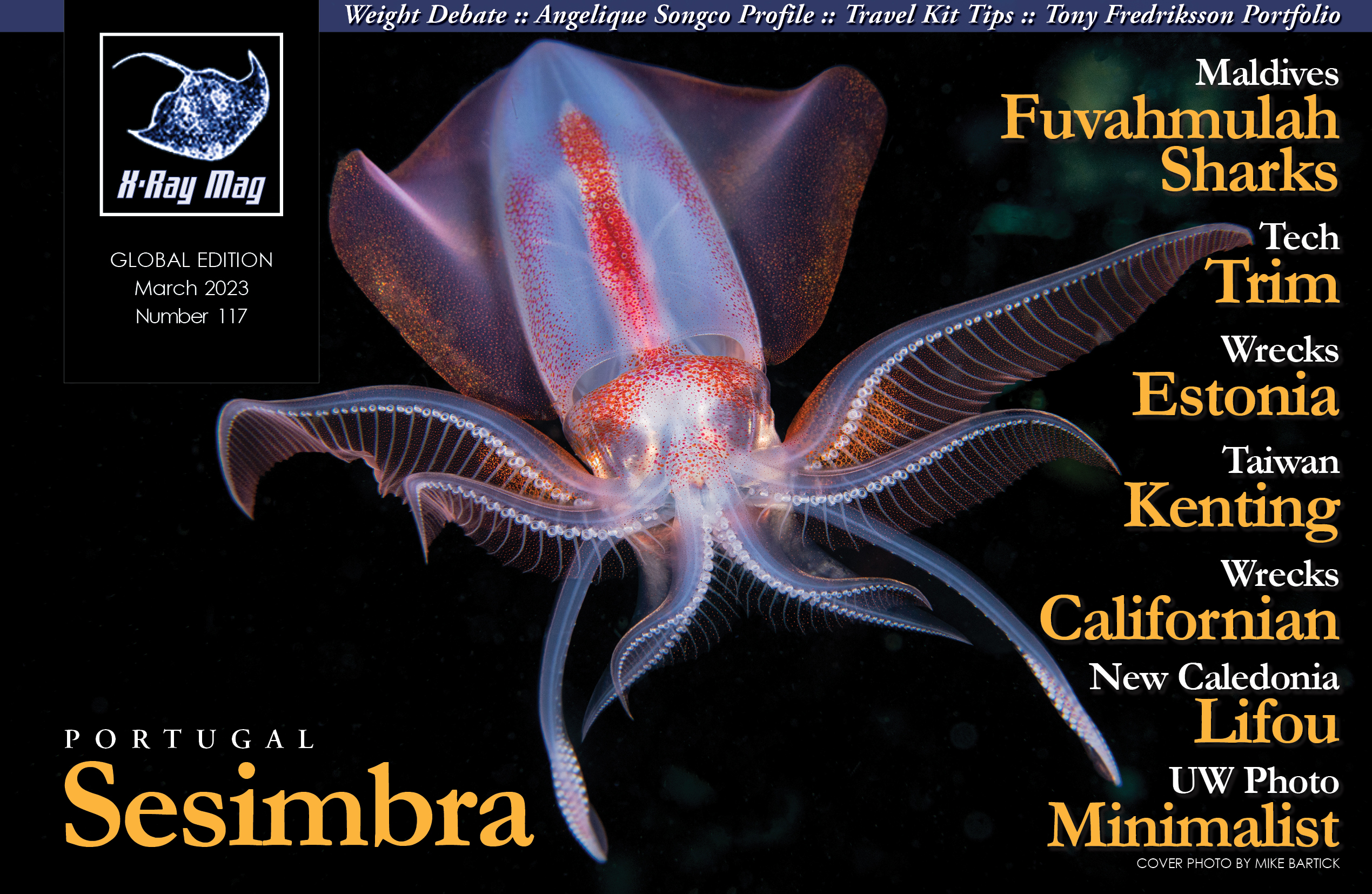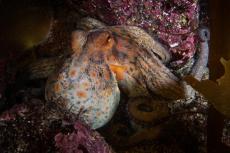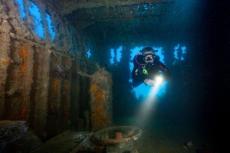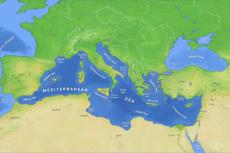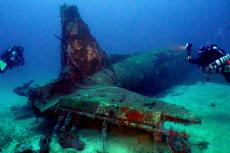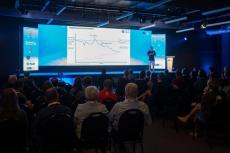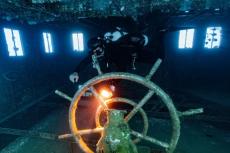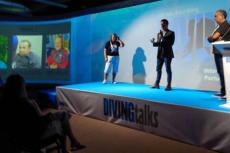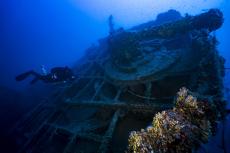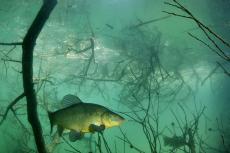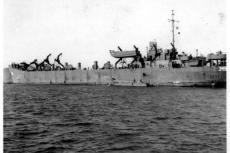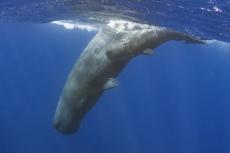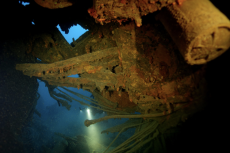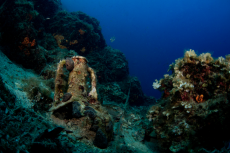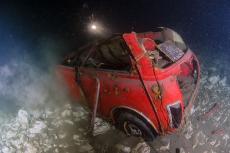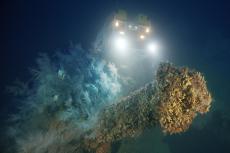Along the coast of Portugal, just south of Lisbon, is the Arrábida National Park, founded in 1976. It protects an area on the southern part of the Setúbal Peninsula that covers 175.41 sq km (68.11 sq mi) of land and sea. Brandi Mueller shares her adventure in Sesimbra, which borders the marine preserve that hosts a plethora of marine species.
Contributed by
Home to over 1,400 species of marine life, the Professor Luiz Saldanha Marine Park was included in the Arrábida National Park in 1998 and is completely protected from all human activities, allowing it to recover from previous degradation. No fishing, boating or even diving is allowed in this area.
Just next to this protected area is the village of Sesimbra. While fishing, boating and diving are allowed here, it reaps the benefits of being adjacent to such a successful marine reserve and where the diving is known to be excellent.
While preparing to attend and speak at Diving Talks 2022 on the Tróia Peninsula, I decided that if I was going all the way to Portugal, I might as well dive there too. While the Azores and Madeira are better known for diving, Arlindo Serrão, of Portugal Dive and one of the founders and organizers of Diving Talks, suggested I check out some of what mainland Portugal has to offer. This sounded like a great idea, especially because I usually like visiting places that are not necessarily on everyone’s radar.
Soon enough, my plane landed in Portugal, and I was immersed in a fantastic weekend of listening to some of diving’s most influential speakers as well as interacting and chatting with them. Diving Talks, in its second edition, was a refreshing event focusing on 20-minute talks by speakers and lots of conversation afterwards. Coffee breaks, lunches and dinners were my favorite moments, as the conversations continued sometimes late into the night. While I still feel the shadow of the pandemic on the dive industry, the weekend was a lovely bit of sunshine showcasing the inspiration and passion of divers and shone a bright light for the future.
Sesimbra
As the whirlwind of talks about diving concluded, I headed to Sesmibra, a short car ride north from Troja and only an hour’s drive south of Lisbon, and absolutely melted into the comfort of the Four Points by Sheraton Sesimbra hotel. Sitting high above the village, my room had a gorgeous view of the pool and onwards to the ocean. I had a day of relaxing and recovering at the hotel and catching up on work. It started with the elaborate breakfast buffet that came with the room; it had eggs, meats, cheeses, pastries, fresh juices and more. Later, after my work was done, I enjoyed a nice, quiet dinner at the same restaurant with a salad and burger and an extensive local-wine list.
The next morning (after indulging again in the lovely Four Points breakfast), Maria from Anthia Diving Center picked me up and brought me to the dive shop. Close to the harbor, the shop has a storefront, classroom, full changing room with showers and a staging area to prepare dive gear. Due to airline luggage restrictions, I had left behind my wetsuit and fins, something I almost never do. I had seen online that they offered high-quality rental gear, including 7mm semi-dry wetsuits. Maria and dive guide Pedro helped to equip me with a wetsuit and fins, and I set up the rest of my gear and loaded it onto a trailer.
It was a weekday, so the shop was slower than it would be on weekends, with only a few other divers present. After loading gear, we were told to climb on the trailer and hold on. A creative way to get to the dive boat, with the trailer carrying us, pulled by a 4x4 Mule utility vehicle. (One could easily walk the short distance to the boat if desired, or ride in a golf cart that followed, but I liked the small adventure of riding along with my gear.) A large inflatable dive boat, the Jori IV, was waiting for us and we passed gear that was secured in the center. The boat departed, heading south out of the harbor.
Jardim das Gorgónias (Garden of the Gorgonias)
Our first dive site was only a short ride from the harbor and, with the help of the crew, we geared up and backrolled into the water. I was thankful for the 7mm semi-dry suit as the 16°C (61°F) water surrounded me, and I felt a twinge of regret for not bringing my drysuit. But the cold was forgotten as we reached the sea floor and an octopus peeked out from a hole dug under the concrete block securing the mooring line. It had shells stacked outside its den from previous meals and its eyes peered up at us.
We continued along a reef area with kelp growing on all the rock surfaces, providing hiding places for fish within. Very quickly into the dive, the octopus count shot up to four, with two possibly courting each other. They were both fully out on the reef with tentacles curling and moving all around, in an elaborate octopus mating dance.
As the dive site name suggest, lots of colorful gorgonias dotted the area and gave bright hits of color against the green blades of kelp. When we returned to the mooring line, the octopus was no longer home; it probably got tired of divers observing it and so we headed up the line back to the boat.
Pedra do Leão (Lion’s Stone)
Back on the boat, we moved only a short way and dive guide Harriett tried to show me the shape of a lion in the limestone cliffs in front of us. I am not quite sure I actually saw it, but I agreed, and under the lion-shaped stone was our next dive site. This site had more kelp than the last dive and we followed a path leading to a large arch that was almost blocked with schools of seabreams and pouting fish. As we swam through, the fish parted and moved out and around the arch in flashes of silver.
Back on the boat, we headed back to the harbor, but paused as a group of bottlenose dolphins went past us. Returning to land, the blue sky was still cloudless and the air temperature around 21°C (70°F).
After changing out of my wetsuit into street clothes, I walked down to the center of Sesimbra. Cobblestone streets twisted and turned with small cafes spreading out onto both the sidewalk and streets with the beach directly in front. It was almost empty apart from a few sunbathers, but I had been told it would be packed in the summer. I enjoyed a leisurely dinner as the sun went down, ready for the next day of diving.
River Popa (Stern of the River Gurara)
With another blue bird day, we headed north on the boat for a wreck dive. The MV River Gurara was a Nigerian cargo ship headed to Britain that got caught in a storm and sank in 1989. It broke in two and the stern section sits at about 28m (91ft). The bow section can also be dived but is several hundred meters away and a bit deeper.
Upon descent, the water got a bit darker and a little colder, and my first view of the wreck was a debris field and a giant grouper! It was too fast for me though; as I tried to get a shot, it disappeared under the wreckage. Kelp was growing on much of the ship and it slowly swayed back and forth with the water movement, almost making it look like the ship was moving, like it would if it were still floating on the surface.
Before the dive, guides Andrea and Harriet told me about a conger eel that lived in a pipe just inside one section of the wreck. That sounded like a great photo op, but I did not know if it was something that was always there, or just if one got lucky. At a break in the wreck, they led me inside and there it was—its body concealed by the pipe, with just the face sticking out. Later, they found another one in a porthole. I guess if you are a conger eel, you would find any circular object to live in.
For our second dive, we went back to Lion’s Stone and found more octopus, a large stingray and tons of nudibranchs. There were so many I decided that I would shoot macro the next day and try to get some images of them. Of course, when chatting with the dive guides, they told me how the next day would also have lots of rock formations and arches that were great for wide-angle as well. Alas, the decisions of a photographer are never easy.
Fish market
Back at the dive center, Alain so kindly invited me for lunch with some of the staff. Close by was the local commercial fishing market, an area not open to tourists. A restaurant inside the market area served the freshest of fish. While I am not usually a fish eater (they are my photo subjects, not my dinner), I will eat it on occasion. Sesimbra was traditionally a fishing village and is still very much one today. The spot was known for its seafood. With the commercial market right there, the fish we were eating were likely caught in the area that day.
You can usually assume a restaurant is good if it is busy, and here, at almost 4 p.m., it was still packed with locals having lunch. The meal started, as most in Portugal do, with olives and bread, and later, blackened swordfish with potatoes and salad arrived. Nothing fancy, but delicious, and the company was great. Anthia Diving Center is a family-run business, and I could tell that all the crew and staff felt like family. I felt honored to be invited into that family for a little while during my visit.
Gruta do Arcanzil (Cave of Arcanzil)
The next morning, with macro lens ready, I immediately reconsidered my choice in lenses as we descended in the best visibility I had seen so far (over least 15m/50ft), and below us was a forest of kelp and other marine vegetation. We followed Pedro, our dive guide, into a canyon-like rock formation, which was an eroded crack in the cliffs of the shoreline.
But not even a minute into the dive, I saw mating nudibranchs on the wall. It was the right lens after all! Searching the wall for macro critters reminded me of being in a dense forest with rocks covered in moss, but here the rocks were covered in algae, sponges, seaweed and other marine plant life—with nudibranchs just waiting for you to spot.
I soon fell behind the group and ran into a diver duo that were also diving with a camera and going slow. We grouped up, pointing out nudibranchs and other critters to each other. (It is so nice to find like-minded divers). They were both dive instructors from Portugal, and whenever I pointed out a nudibranch, I was nervous I was showing them species that was super common to them (but new to me). Back on the boat, they said there was at least one that was an exciting find, even to the locals.
There were also scorpionfish, gobies, blennies and a forkbeard, which was entirely new to me. With a barbel on the chin, it kind of looked like an evil sock puppet. I snapped a few photos and moved on.
Tasca do Isaías
At the same time as I was in Sesimbra, there was a TDI Instructor Trainer Workshop taking place with some of the people I had met the week before, at Diving Talks. They graciously invited me to dinner, and we met at Tasca do Isaías, a local spot the crew at Anthia Diving Center had also recommended.
On offer was fish. That was your option, just fish. There was no menu, only a board with several fish choices. I was told it was best to just order what they recommended. So, letting the group dynamics take over, I just sat back and tried whatever arrived. Similar to my lunch the day before, it was the freshest fish possible, cooked over charcoal to best release the flavors.
To be honest, I often do not even like fish, the rare times I have eaten it. And when one considers the process of fish being caught and sent around the world before being consumed, it is easy to see where it does not make sense (nor does it make for the best dinner). To that end, I find that eating “local” is the best way to go, and this was as local as it gets. It was a fantastic evening of food, drinks and conversation.
Ponta da Passagem
The next morning was a Saturday, and I had been warned that weekends were busier, but there was something great about a bunch of divers getting ready to do what they love. The excitement and anticipation spread through the air.
Returning to my wide-angle lens with promises of more geological structures under the cliffs to photograph, we backrolled off Cetus, Anthia Diving Center’s larger boat, in a postcard-perfect scene of calm, blue water and sun-soaked yellow cliffs rising out of the sea. The underwater scene was just as pretty, and this site had the most abundant kelp forest I had ever seen. The water was still very clear, and the morning sun shone its rays off the cliffs, into the water, and through the kelp.
Very early into the dive, I noticed a tiny yellow and white nudibranch on a blade of kelp (of course, just to remind me that I could have been shooting macro) and then I noticed them all over. I tried to get a shot, but using a fisheye lens to photograph nudibranchs generally just does not work. Harriet caught my attention and pointed under the swaying kelp, down at their holdfasts attached to the rocks. There was an octopus out of its hole and swimming along the bottom.
Batelão (Barge)
The boat moved back near the harbor for our next dive, and the site was just outside the man-made concrete breaker jetty or sea wall. We followed the line down to the small wreck from which the dive site gets its name, and I loved the way the small ship had been covered with marine growth. Small fish darted around anemones and algae.
We moved away from the wreck and over to some concrete structures, which reminded me of giant jacks from a children’s game. The structures were used as a break wall to keep the harbor calm. These structures were covered in marine growth and teeming with life.
At no deeper than 6m (20ft), I was snapping photos left and right, as there was an octopus and then a cuttlefish and then… a John Dory! Flat and circular, this fish had long dorsal fins that looked like a bright yellow mohawk gone wrong. I spent a lot of time photographing this strange-looking fish, which I have only seen once or twice before.
Back on land, it was time to rinse the dive gear and pack up. Many businesses claim to treat you like family, but Anthia Diving Center certainly lived up to that standard. Friendly faces and genuine inquiries into how things were going were carried out by the whole staff. Plus, on some days, there was Mel, an adorable furbaby scuba mascot more than willing to accept belly rubs and petting. I left feeling like I had made new friends.
Castelo
On my last morning in Sesimbra, I got up with the sun to climb the stairs to Castelo de Sesimbra, a medieval stone castle high above the village and port. As I made my way, I had only seen one other person (and his dog) walking along the path, and when I reached the top, I was able to wander around the grounds by myself and take in the views of the lovely city below.
Returning to the Four Points hotel, I indulged in one more breakfast, taking my time, as I had no dive boat to catch. I leisurely packed and made my way to Lisbon via an inexpensive Bolt (Europe’s version of Uber or Lyft), which took about an hour.
After checking into my Lisbon hotel, I set out with no destination and wandered the cobblestone streets that ascended and descended as much as they twisted and turned through the city. I eventually found myself at another castle, this time the Castelo de São Jorge. It was a bigger castle, for sure, but it was crowded with tourists. It sunk in then how lucky I had been to explore the Sesimbra castle all on my own that morning. Seeing the lovely sweeping views of Lisbon from the perch of Castelo de São Jorge showed me the layout of the city and the density of buildings and colorful red roofs.
Continuing to wander, I stopped by one of the many pastry shops for a coffee and Portugal’s famous pastel de nata. These delicious egg custard tarts brought back memories for me of Macau, where I first sampled them. Remnants of colonial Portugal live on through the food still popularly served in those places.
Walking through the Alfama neighborhood, I saw familiar sights of restaurants and cafes spilling out the doors into the streets. People were sitting at tables in the shade of umbrellas, looking completely relaxed with various glasses of wine, beer or Aperol spritz. I stopped for a sandwich and a porto tonico, which came in a giant glass with whole slices of lemons and a cinnamon stick. This refreshing drink used white port mixed with tonic water, and was great to cool down with, in the afternoon sun.
As my trip was coming to an end, I reminisced about how nice it had been. Good diving, food, drinks, lovely sights, and absolutely fantastic people. Portugal seems to value the importance of every moment and how you spend it. I look forward to the next Diving Talks, and hopefully, a bit more diving around this beautiful country.

